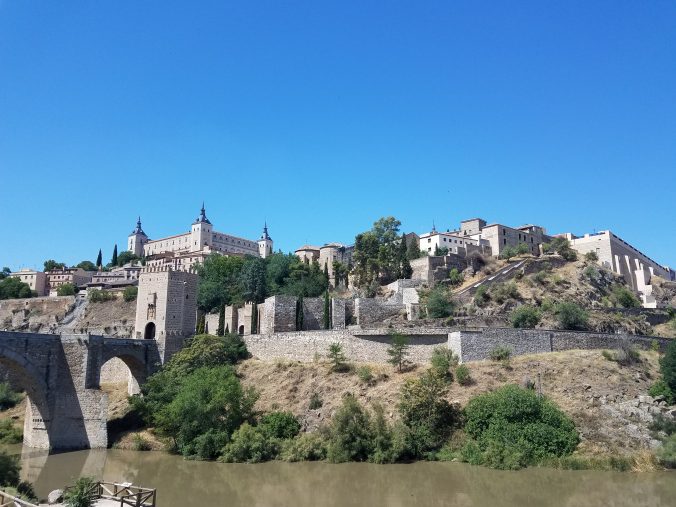I time traveled today.
After thirty minutes on a train, I found myself in a whole new world.
El siglo de oro, the peak of the Spanish Empire.
I stared up at the stately city with awe. A large stone fortress sat atop a hill with buildings in the same fashion layered below it.
A bridge with a brown river flowing underneath stood guard to the entrance to the city. With the sun beating upon my shoulders I approached the guard to the city.
Upon entering, I was greeted with an archway that opened to the steps that would bring me to the top of the hill. I recognized the style of the arch, it was something that was unique to this city and others near it. It wasn’t like a simple archway with a rounded top or point, this arch was different. The sides of the door way were straight but they were then met with a semi-circle at the top, much like a keyhole. This type of architecture is synonymous with the Moors, a group of Muslim peoples from North Africa. In order to reach the top of this city and still to this day it was the key to reaching the city.
I continued to scale the steps that cascaded down the hill in front of me. The path eventually led to the main plaza, where the people would congregate to sell their goods and have a meal. Many tiny little streets and alleyways followed away from this hub to the various parts as the winded and turned.
Down one of the larger streets was the fortress that I had viewed from below. Up a short hill to the building, a rectangular stone structure with towers at all four corners and atop this tower were spires that stretched above towards the heavens, this structure is named the Alcázar. Once a fortification originally used by the Romans when they occupied the area in the 3rd century it was rebuilt several times of the centuries after siege but the fortress still stood strong. At the top of the construction, is a terrace where it became clear as to why this location was chosen for the stronghold. There are 360 degree views from atop the hill into the countryside and of a strategic position as a natural river flows around the perimeter to offer as a secondary layer of defense. The kings and queens of Spain would have taken residence here and would have greeted their subjects from their thrones. Even a Hernan Cortes, who would be returning from his encounter with the Aztecs and the fall of Tenochtitlan, seeking the support from Los reyes catolicos. He would have traveled to this city on a hill with stories of the New World and the riches that he he encountered.
Another structure, sprouted from the center of the city, standing tall amongst all the buildings was the cathedral. En route to the cathedral, it became more evident that I was no longer in the 21st century. Draped above the streets, large sections of canvas were suspended above the city streets. They were tied to the walls above and provided much needed shade from the day as you walked along the streets. I imagined ancient Roman legions, Visigoth warriors and Templar knights walking beneath the cloths with their swords and armor or perhaps even kings and queens in procession. The multi spired building that provides guidance to those who enter. Several entrances are located on different streets but the one that you must enter is down a narrow street that opens to the grand entrance.
The entrance is adorned in carvings from the Bible and other religious figures. The doors are crowned with a pointed archway that adds to the grandnessof the cathedral. Beyond the large carved doors lies the grandiosity of baroque Spain. Upon entrance you are greeted by large stone pillars that seem to never cease to climb into the sky. The pillars stretch to meet the ceiling, a collage of marble, sculpture and gold. To the sides the cathedral is lined with chapels, all dedicated to different saints and important figures. The choir, one of the most prominent features, located in the middle with organs gilded in gold. You can imagine that when mass is being performed that the organs and the choir would resonate beyond the city and into the nearby pueblos. A balcony hung from the wall above the choir, where Queen Isabel I would have sat during a mass, to be able to enjoy all aspects of the ceremony.
Soon, I would have to return to the reality that I know, not this one of grandeur, faith, armor and siege. I would return on the train once more. As I sat and waited for the train I stared at the city on atop the hill and wondered what else happened here that the history books don’t know about. The train sped into the station and stopped right in front of me. I approached the coach and for once last time I turned to the city.
Ciao, Toledo.

